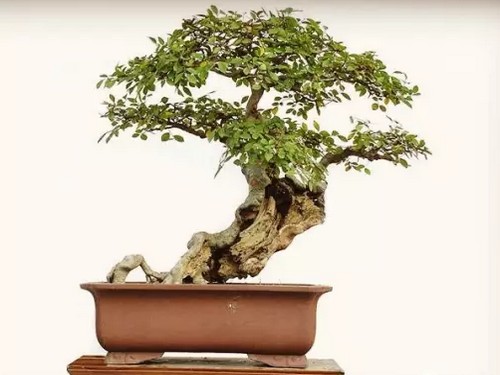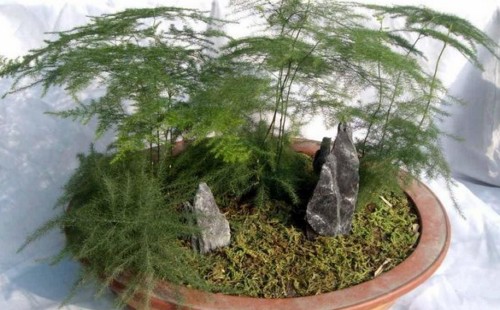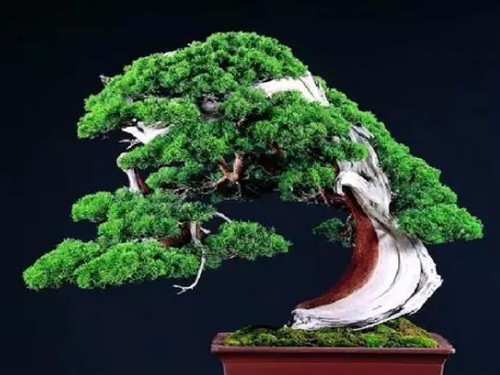Selection and cultivation of bonsai of Ulmus pumila
Hammer elm is small leaf elm, but not elm, its shape is more elegant, the biggest feature is bark and trunk mottled, autumn leaves will change color, belong to deciduous trees, casually very easy to raise, but not very suitable for beginners! Its horticultural varieties are full of diseases and insects, but it doesn't stop people from liking it!
Hammer elm is an ordinary tree, which can be found in the mountains and fields all over the world. The appearance of nut elm is elegant, the leaves are small and green, elegant and unrestrained, full of vitality, clear hierarchy, dense, intertwined, hanging roots and claws. Regardless of the size of the pile head are solemn Athens, majestic. In particular, the ancient pile head is a beautiful cave, vigorous and simple, Qiu qu strange, old age. The branches are unrestrained, tall and straight, with the feeling of ancient trees in every spring.

The seedlings of nut elm can be propagated by sowing. From October to November, the seeds are ripe, harvested in time, spread out to dry, poplar to sundries, bagged and stored. Sowing in March of the following spring, sowing on almost the whole seedling bed on a windless and sunny day, covered with fine soil, with no seeds for the degree, and then covered with straw. It can be germinated and unearthed in about 1 month, uncover the grass in time, and plant seedlings appropriately. During the period of seedling growth, we should do a good job in water and fertilizer management, loosen the soil and weed, and the seedlings of the same year can be as high as 30cm and 40cm. It is suitable for inverted bed culture for several years, trimmed and reshaped, and then processed in the basin. Can also dig mountain water edge hammer elm old pile, choose root dew stem thick, suffer force twists and turns, branch horizontal slope, leaf thin J, posture ancient clumsy. After raising the embryo, when the root system is developed and the new branches and leaves are luxuriant, it will be shaped by the potted mouth.
Artificial reproduction:
Ulmus pumila usually sows and propagates. From October to November, the seeds are ripe and the fruit wings are yellowish brown. They should be harvested in time, spread out and dried, sundries removed and stored in bags. Sowing, sowing or strip sowing in March of the following spring. The row spacing of strip sowing is 25 cm, sowing on a windless and sunny day, covered with fine soil, with no seeds for the degree, and then covered with straw. It can be germinated and unearthed in about 30 days, so the grass should be uncovered in time and the seedlings should be suitable. During the growth period, we should do a good job in water and fertilizer management, weed and loosen the soil, and the seedlings of the same year can be as high as 30cm and 40cm. Young tree seedlings have sparse dry twigs and large leaves, which are generally not suitable for making bonsai. They should be cultivated for several years. After pruning and shaping, it is better to go on the basin. In addition, Ulmus pumila can also be propagated by root cuttings to cultivate pile materials, which has a fast effect and is widely used in South China.
Mountain mining:
There are many elm growing in the south of the Yangtze River, and the limestone mountains are more common. The old tree stump that has been cut down for many years, especially the elm stump growing in barren slopes, river ditches or mountain stone gaps, is slow in development, long in age, processed by natural wind and waves, thick roots, vigorous twists and turns, oblique and horizontal branches and leaves, and small leaves. The best one is old and clumsy. Dig before sprouting in spring, cut off unnecessary roots and branches, protect accessory roots and whisker roots, beat mud and wrap them with wet moss. After digging back, choose the land with ventilation and light, loose and moist soil for deep buried cultivation, which is called "embryo cultivation". When the root system is developed and the new branches and leaves are luxuriant, they will be processed and shaped in the basin. Take the old pile as the bonsai material, can shorten the bonsai processing time, and the shape is natural and simple, different from ordinary goods, and easy to survive.
It takes at least 2 to 3 years for the old tree stump to be cultivated. A rapid culture method is introduced here, which is especially suitable for the growth of bonsai. The hammer elm stump dug back in early spring was first planted in a tile bowl, and after survival, the unwanted buds were picked at any time, and the posture began from the end of April to the beginning of May. When the branches grow to 15-18 cm long, use thin wire to climb and shape, and pay attention to maintenance and management. When sprouting new branches and growing 4-6 leaves, pruning can be carried out. Generally, only two leaves are left on each twig, and nitrogen fertilizer is applied immediately to promote the emergence of new buds on the new branches, so that the leaves can grow thickly as soon as possible. With the continuous thickening of branches, the wire must be removed in time to prevent "trapping". For the unshaped branches, they can be clamped up again to fix their shape. In this way, a pot of nut elm pile scene can be initially formed in September.
The key to this rapid prototyping method is mainly climbing when the xylem of the branch has not yet hardened, so the production should be made with special care, the thickness of the wire should also be selected properly, and the winding should not be too tight to prevent damage to the delicate branches. In addition, it is also necessary to do a good job of "raising embryos" in order to achieve the goal of digging piles for one year to make bonsai.
Time: 2019-06-02 Click:
- Prev

What kind of soil is used in asparagus culture?
Asparagus is suitable for growing in a warm, humus-rich and permeable soil environment, so whether the soil is good or not often determines the growth state of asparagus to a large extent. If we can prepare a high-quality culture soil that is fertile and loose, permeable and permeable, then it will provide a good physical basis for raising asparagus.
- Next

Material selection and cultivation of real cypress bonsai
Real cypress bonsai has always been famous in bonsai circles at home and abroad for its old stem, tight leaves and graceful posture, especially in Japanese bonsai exhibitions, which are made of century-old cypress, with white bones and red skin, such as swimming dragons, vigorous and simple, with Xianjia style, which can be called the top grade of bonsai. The true cypress of potted plants in Taiwan
Related
- Fuxing push coffee new agricultural production and marketing class: lack of small-scale processing plants
- Jujube rice field leisure farm deep ploughing Yilan for five years to create a space for organic food and play
- Nongyu Farm-A trial of organic papaya for brave women with advanced technology
- Four points for attention in the prevention and control of diseases and insect pests of edible fungi
- How to add nutrient solution to Edible Fungi
- Is there any good way to control edible fungus mites?
- Open Inoculation Technology of Edible Fungi
- Is there any clever way to use fertilizer for edible fungus in winter?
- What agents are used to kill the pathogens of edible fungi in the mushroom shed?
- Rapid drying of Edible Fungi

